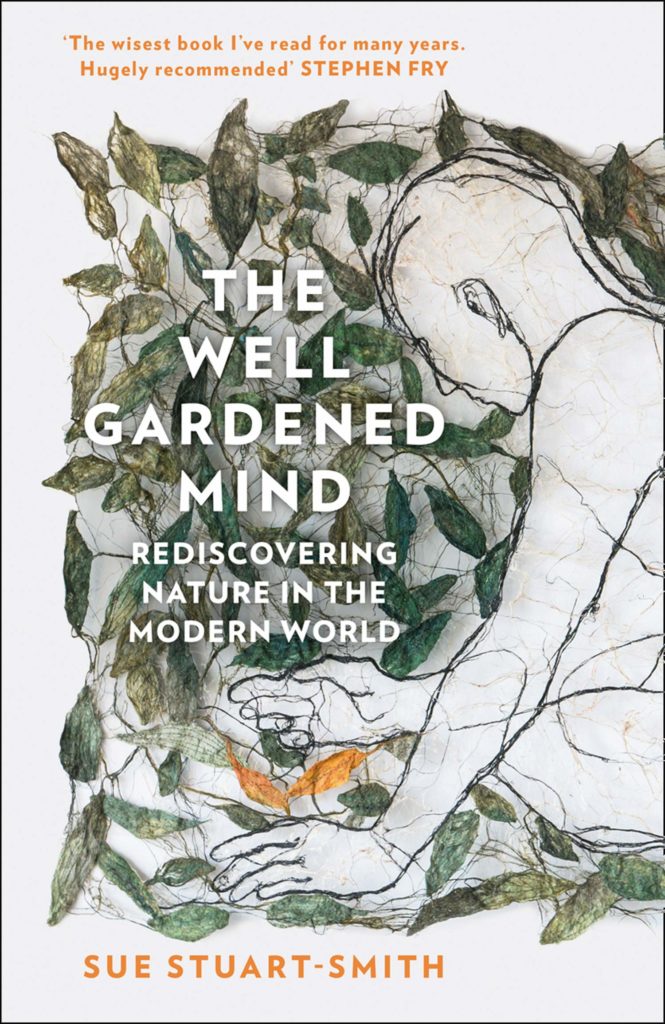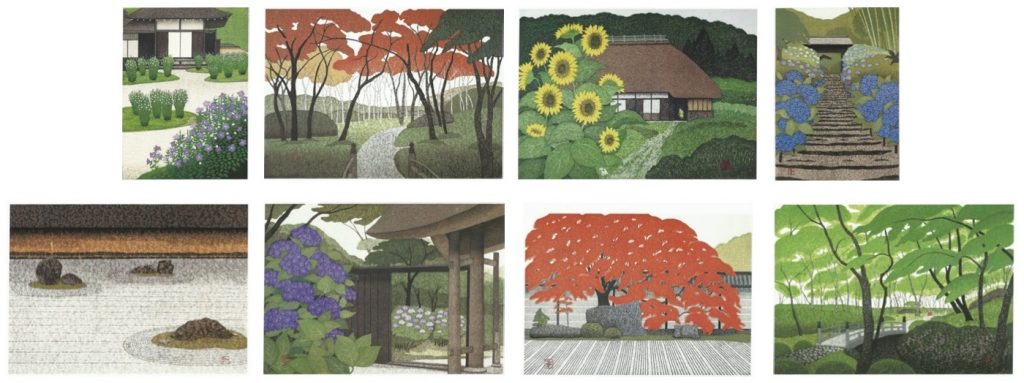Blog
The Well Gardened Mind – Rediscovering Nature in the Modern World – Sue Stuart-Smith
There are so many books on gardening it’s untrue! And a thousand more are seemingly released every year! You would think that everything there was to say about gardening had been said, over and over again. Books on ‘how to’, – how to grow flowers, how to grow fruit and vegetables, how to propagate; books on aesthetics and design; coffee-table books full of sumptuous photographs of gardens around the world. But there are far fewer books on just why we garden, what drives us to do it, what are its benefits? In my opinion, such books are far more interesting. Sue Stuart-Smith has gathered together recent scientific research, numerous case-studies, current human evolutionary theory, her own life experience – as a practicing psychiatrist and psychotherapist, as an experienced gardener, her own health story and her family history – into a fascinating tome about how ‘green’ is good for us. About how we evolved within nature for millennia and how our […]
 Continue reading...
Continue reading...
Kazayuki Ohtsu (Japanese woodblock artist, born 1935)
Images of calm, of stillness. Gardens and nature simplified, made perfect. Windows onto another world – this world…, but not quite. Top row, left to right: Hana Fuu Ga, 2015; Garden in Autumn, 1999; Sunflowers in Summer 2012; Myogetsu-In at Kamakura, 2004. Bottom row, left to right: Stone Garden at Ryoan Temple in Kyoto, 2006; Hydrangea at Tokei Temple in Kamakura, 2008; Stone Garden in Autumn, in Kyoto, 2009; Green Garden at Hakone, 2007.
 Continue reading...
Continue reading...
RHS Chatsworth – The Path of Least Resistance Garden
A garden of ‘weeds’ – Yarrow, Daisies, Knapweed, Spear Thistle, Teasel, Poppies, Docks, Campion, Comfrey, Dandelions, Buddleja and many others. For me this was by far the best garden at the inaugural RHS Chatsworth show! Design and built by three young landscape architecture students from Leeds Beckett University – Zuzanna Golczyk, Tom Rawlings and Frankie Tomany – whose concept behind the garden was: ’Looking to the unsung heroes of the plant kingdom, the renegades and survivors of urban landscapes, who thrive in their humble settings.’ Essentially they are encouraging a new look at plants we too often only see as there to be eradicated. The design had been put together with great skill; materials such as crushed tarmac, concrete and brick being very artfully laid out and the sensitive layout of the plants was supported by geometric sculptural forms welded from rusted road-pins. The garden was beautiful overall but it also encouraged you to examine the commonplace more closely and […]
 Continue reading...
Continue reading...
child’s play
The opportunities to promote child’s play in the garden are endless. Obviously children can be encouraged to garden themselves, perhaps with their own little plot, but I’m thinking here of actual physical and imaginative play as opposed to ‘learning’. The images above all suggest ways to incorporate ‘natural’ play into the garden but there are many others. Sand and water are two of the best materials, especially for toddlers, to include in a garden. Add a child’s own digger toys, buckets, spades etc. and hours and hours of play, (and mess!), are possible. They may seem rather obvious but these materials never go out of fashion as a child’s creative imagination can really be let loose. If you are worried about cat mess in sand then use a sand pit. If you are worried about water and safety then very shallow rills, (e.g. for dam building or boat sailing), are a really good idea or just have containers than can […]
 Continue reading...
Continue reading...
A Quiet Corner
This sublime little garden was at RHS Tatton recently. It was designed by a new partnership, JarmanMurphy. You can find them here:- https://www.facebook.com/pages/JarmanMurphy/578643315608997 It was one of the small ‘back-to-back’ gardens but, in my opinion, was easily the best garden in show beating all the bigger gardens hands down. Called ‘A Quiet Corner’ it consisted of a cobbled path leading to a small sitting area with a pair of simple wooden block seats. An elegant steel water bowl was set to one side and the area was backed by a grey rendered wall finished with a thin sheen of pewter metallic paint. A multi-stemmed Field Maple added height – essential in a small space. The herbaceous under-planting was perfectly executed: grasses, ferns, thyme, sanguisorba, allium and erigeron amongst others – a very light, naturalistic style and the way the shadows of the plants danced on the wall was just wonderful. My description certainly does not do it justice! The designers […]
 Continue reading...
Continue reading...
wabi-sabi
Wabi-sabi is a comprehensive Japanese aesthetic centred on the acceptance of transcendence and imperfection. It is the aesthetic behind many traditional Japanese art forms such as ikebana (flower arranging), traditional Japanese pottery, the tea ceremony and zen gardens. According to Leonard Koren, (Wabi-sabi for Artists, Designers, Poets and Philosophers’, 1994), wabi-sabi is:- a beauty of things imperfect, impermanent, and incomplete; it is a beauty of things modest and humble; it is a beauty of things unconventional. Characteristics of the wabi-sabi aesthetic include asymmetry, roughness or irregularity, simplicity, economy, austerity, modesty, intimacy, and appreciation of the integrity of natural objects and processes. How might this aesthetic be translated into western garden design when, as seen at Chelsea every year, we are now so used to chasing the new, the perfect, the shiny and the aspirationally expensive?
 Continue reading...
Continue reading...
A cherry blossom haiku
the cherry flowers bloom, we gaze at them, and then they fall… (with apologies to Uejima Onitsura! (1660-1738))
 Continue reading...
Continue reading...
Bang! – the Forsythia has exploded – Spring is here!
Can there be a more maligned shrub than poor old Forsythia? Unappreciated to the point of derision and if it does feature in a garden it is usually really badly pruned. Yet it’s annual explosion of ‘yellower than yellow’ blossom is surely one of the truest signs of the arrival of Spring. I’ll admit it – I used to deride Forsythia as well. That was until I inherited one and now, another property down the line, we are onto our second. Now I’ve learned to love it and I look forward to it’s blossoming as a sign that Winter is finally over. The trick, (as with a lot of deciduous flowering shrubs), is to learn how to prune it so as to let it express it’s natural form. If pruned properly Forsythia has a sort of natural arching grace, slightly scruffy I’ll grant you, but those arching sprays of blossom, (if not ruinously cut into that classic ‘bog brush’ look!), […]
 Continue reading...
Continue reading...
Herbs – grow your own ‘great flavour enhancers’
Growing your own fruit and vegetables has become very popular over the last few years. However not everybody has the time, space or inclination to do this. But if there is one group of plants I think everyone should have a go at growing it is culinary herbs, even if it is just a few pots of basil on the kitchen windowsill. The reason for this is that fresh herbs can absolutely transform a meal; they are ‘the great flavour enhancers’. It’s a simple joy to be able to collect some rosemary and a couple of bay leaves whilst cooking a winter casserole, (and once you’ve tried fresh bay leaves you’ll never go back to those grey cardboard ones from the supermarket!); or snip some fresh mint in summer and indulge in a luxury mojito… If you have a large garden then a small part of it could become a dedicated herb area. In smaller gardens there are various options […]
 Continue reading...
Continue reading...
The Winter Garden
Just when the weather is at it’s bleakest – grey, wet, cold and generally downright miserable. Just when we could probably all do with some cheer – some colour, some signs of life, some greenery – we give up on our gardens. Or by and large we do. This is a shame, because there are many plants that are at their most beautiful at this time of year. In recent years there have been efforts to overcome this tendency as various people and gardens have developed ‘The Winter Garden’. Among the very first was at Anglesey Abbey in Cambridgeshire, a National Trust property, but others have followed, for example the winter borders at the RHS garden at Harlow Carr. Other gardens, such as Hodsock Priory, near Worksop, open especially to display extensive snowdrop collections. This hopefully gets us out and about, visiting these properties and getting some fresh air, but there is no reason why you cannot enjoy a winter […]
 Continue reading...
Continue reading...